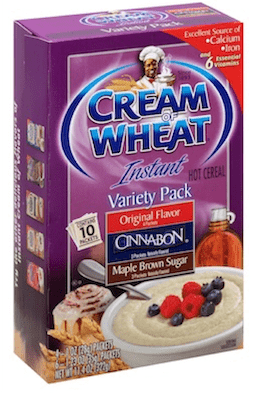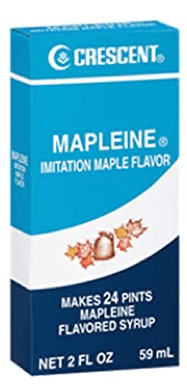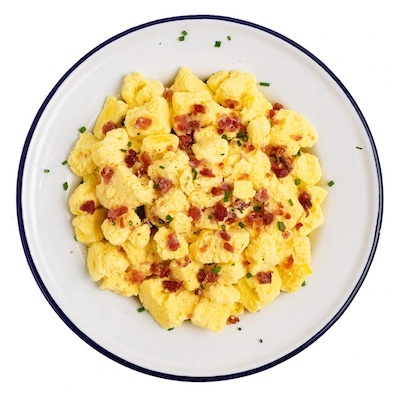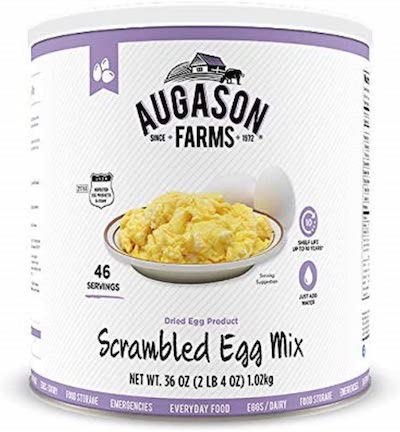Preparedness Challenge Week 17
Thanks for joining the 2022 Preparedness Challenge!
This week the challenge is to make your own customized supply of breakfast foods. The idea is to collect several breakfast foods and put them together in one food-storage bucket. Or if it works better for you, add them to a dedicated space on your food storage shelves. In an emergency you will have your breakfast food located in one convenient place.
What Should You Put in Your Breakfast Bucket?

To begin, choose shelf-stable breakfast items that your family likes to eat. This can include various cereals such as oatmeal, farina, cracked wheat, cornmeal, and rice. Add pancake mix or muffin mixes and dehydrated or freeze-dried eggs. Include dried and canned fruit as well as fruit juices.
How Much Should You Store?
Two goals for the 2022 Preparedness Challenge are to (1) help you build your food storage and (2) to keep things simple. With those goals in mind, the challenge this week is to select enough breakfast entrées for two weeks. For a family of four that would be 28 breakfast entrée servings.
The challenge this week is to add enough breakfast entrées to your food storage for two weeks.
Of course, this is just a beginning suggestion. You may want to double this amount so you have enough for one month. A good goal is to eventually acquire a three month’s supply of foods you use every day.
Breakfast Food Storage Options
The three main options for breakfast entrées are cooked cereal—both instant and regular, pancakes, and eggs. They are each discussed individually. Ideally, mix and match so you have some of each type of breakfast food.
OPTION 1—COOKED CEREAL
Instant Cooked Cereal
The simplest option is to purchase enough cooked cereal variety packs for your family for two weeks. They are easy to prepare, requiring only boiling water and a bowl or cup. They are a bit more expensive than other cooked cereal options and the servings can be a little low on calories.

Oatmeal, Cream of Wheat, Cream of Rice, Zoom, and even keto cereal brands all come in boxes of individually packaged cereal. They come in a variety of flavors, and a varying number of packets are offered per box. The serving size for the packets is only about half a cup, so you may want to double the number of packets. They are a little high on added sugar, but in an emergency that isn’t a bad thing.
The shelf life for cereal packets in their original packaging is about two years.
Regular Cooked Cereal
Select a variety of cereals for cooking—a canister of oatmeal, a box of farina, a sack of cracked wheat, a package of rice cereal, a container of cornmeal, or cereal in bulk. Larger packaging and cereal sold in bulk is less expensive and will give you the option of cooking cereal for several people at once. You can also control the amount of salt and sugar added and the size of the servings. Check the containers for the number of servings and be sure they add up to your desired two-week number of servings.
Cereals in their original containers have a shelf life of about two years.
OPTION 2—PANCAKE MIX

Pancakes and their close relative, waffles, are another breakfast-food option. Look for complete pancake mixes that only require adding water. Or make your own pancake mix. Before purchasing a large quantity, try several brands to find out if you like them. As a minimum, purchase enough for one or two servings a week.

Also store pancake syrup or sugar and maple flavoring to make your own syrup.
A complete pancake mix contains milk, egg, and shortening products which affect its shelf life. In its original packaging, pancake mix has a shelf life of about two years. Repackage and store in airtight containers. For convenience, measure pancake mix into ready-to-use meal sizes and repackage in resealable bags.
OPTION 3—EGGS
For some people, breakfast isn’t breakfast without eggs. In an emergency when fresh eggs are unavailable, freeze-dried or dehydrated eggs are a good substitute. Eggs can be a challenging storage food because they are unfamiliar and may not taste the same as fresh eggs.
Fresh Eggs
In the United States and Canada fresh eggs are washed and sanitized which removes the protective bloom, requiring that they be refrigerated. Although the stated shelf life for fresh eggs is about a month, they may store up to six months if refrigerated. One way to guarantee that you always have eggs is to continually keep a two-week supply in your refrigerator.
Freeze Dried Eggs

Freeze-dried eggs are cooked scrambled eggs that have been freeze-dried, and they are extremely convenient. They require no further cooking and are reconstituted with boiling water. They come plain or with additions like bacon, ham, sausage, peppers, and onions, or in combination foods like “breakfast skillet.” They are not suitable to use like raw eggs so are not used to make French toast or as an ingredient in other recipes.
Freeze dried eggs are packaged in Mylar pouches or #10 cans with oxygen absorbers and have a shelf life of thirty years. Because they rapidly absorb moisture, their open shelf life is only about a week. It is a good idea to repackage the large cans into smaller pouches once opened.
The biggest disadvantage to freeze dried eggs is their cost—about what a fast-food breakfast would cost. Also, try them before purchasing a large quantity. Manufacturers change their products over time.
Powdered Eggs

Air-dried powdered whole eggs and scrambled-egg mix with added milk and vegetable oil are the most common forms of powdered eggs for food storage. Powdered eggs can be used in egg dishes and in baking, added directly to the dry ingredients. Scrambled egg mix is reconstituted and used for egg wraps, frittatas, omelets, French toast, casseroles, and scrambled eggs.
Dehydrated eggs are two to three times more expensive than fresh eggs.
Things to watch for when purchasing dehydrated eggs:
- Compare prices—the same product varies considerably from vendor to vendor.
- Check the serving size—a large egg has about 80 calories.
- Sample, if possible, before purchasing large quantities.
- The quantities in similar sized cans may not be the same.
- Be aware that shelf-life claims for dehydrated eggs may be exaggerated,
The shelf life of powdered whole eggs depends on how you want to use them. For best quality and to most resemble fresh taste in scrambled eggs or omelets, plan on a shelf life of about two years. For use in baking, the shelf life is five to ten years. The shelf life for scrambled-egg mix is up to ten years. The shelf life after opening is three to four months. You may extend this by repackaging with oxygen absorbers.
Egg Crystals
Egg crystals are sold under the brand name Ova Easy and manufactured by Nutriom. They are another form of dehydrated egg that many find to be fresh tasting and an improvement over regular dehydrated eggs. They have the functionality of fresh eggs; however, they are more expensive than fresh or dehydrated eggs. Their shelf life is seven years.
Laying Hens

Another way to have fresh eggs is to own your own laying hens! This may or may not be possible based on where you live and your zoning laws. Two years ago, we decided to give raising laying hens a try. Craig has been tending six laying hens for over a year and it is so nice to have a fresh supply of eggs! And grandkids love to come visit them!
Tips for a Longer Shelf Life
Increase the shelf life for dry and dehydrated foods with additional protection.
- Place small packages in resealable plastic bags.
- Repackage cereals or mixes from paper sacks or boxes into large resealable plastic bags.
- Use a vacuum sealer to package several small packages together for a family-sized meal.
- Use Mylar bags and oxygen absorbers for maximum shelf life.
- Package items and then freeze at zero degrees for 72 hours to minimize insect infestation,
- Store all cereals and grains in a cool, dark, dry location.
What about Buying a Ready-Made Breakfast Bucket from a Food Storage Company?
It is true that you can purchase ready-made buckets of breakfast foods as well as other meal packages. There are a couple of advantages to this approach.
It is simple to just purchase a food supply already put together and be done with it. These foods have a long shelf-life and the buckets are stackable.
It might be tempting to do this, but there are a few disadvantages.
DISADVANTAGES TO PURCHASING COMMERCIAL FOOD STORAGE
- The biggest disadvantage is the cost! They are super expensive! You will pay a lot for oatmeal and cooked wheat cereal!
- The servings are often small and the product is loaded with added sugar.
- Sometimes they claim to be freeze-dried, but the cereals require twenty minutes to cook which means they are not freeze dried. Freeze dried foods are ready instantly!
- They may not fit your family’s tastes and preferences.
- You lose control over what is in the storage bucket.
Learn More
Find out more about storing foods in Crisis Preparedness Handbook, Third Edition (2020). If you don’t already have a copy, you can find it here on my website CrisisPreparedness.com. Or, read it on Amazon in the Kindle version or hard copy version.https://amzn.to/3vL10gi




6 thoughts on “Build a Breakfast Bucket”
I just signed up for your email week 17.
How can I find weeks one thru sixteen?
Thanks so much for your interest. On the CrisisPreparedness.com website under Blog in the top menu bar you will find links to all the articles.
Ms. Aston, in the section on Tips for a Longer Shelf Life, you said “Store all cereals and grains in a cool, dark, damp location.” Did you mean to type “dry location”?
Your comment made me laugh! Thank you for pointing that out. I will fix it.
Hi Patricia! I’d love your take on the best mylar bags and vacuum sealers. This seems like a super handy tool but I’m overwhelmed by the variety- and cost of bags! Any advice?
Hey, if you are looking for more resources, check out my website QU6 as I cover topics about Thai-Massage. By the way, you have impressive design and layout, plus interesting content, you deserve a high five!